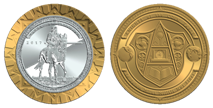Hi all, I just wanted to share this article with all forum members. Hope you enjoy

King Farouk the First of Egypt, who reigned from 1936 until 1952, was a prolific collector. His taste for the rare and unusual was the catalyst for his assemblage of a diverse collection of items from around the world, even including some unsavory "collectibles." His coin collection included an estimated 8,500 gold coins and medals. King Farouk made most of his coin purchases in the 1940s, in an era when a numismatic dollar (and an Egyptian pound) went a long way.
Several American dealers supplied the king with coins, but they soon discovered that a downside to selling to him was that it usually took a long time to receive payment, especially if the invoice totaled more than $10,000. The larger invoices had to be routed to the Egyptian treasury, significantly increasing the time it took for the payment to be received, whereas the king had the authority to authorize payment of the smaller invoices. Not surprisingly, the American dealers soon learned to limit the invoices to less than $10,000. When all was said and done, King Farouk had amassed one of the largest, most important collections of coins in the history of numismatics.
The King Farouk Auction: A Numismatic Legend After the Egyptian military forced King Farouk to flee the country in 1952, the American coin dealers had a great interest in what was to become of the Farouk Collection. Abe Kosoff goes into great detail in his book concerning the pre-sale uncertainty and negotiations that took place. Eventually the Egyptian government established a sale date and the London firm of Baldwin & Co. was hired to describe the coins, with Sotheby & Co. publishing the catalog. The coins and medals volume was one of a set of Sotheby catalogs entitled The Palace Collections of Egypt , which offered several categories of the king's collectibles, but did not mention King Farouk by name.
Because Fred Baldwin had to catalog the coins in Cairo, under military guard, and in a short period of time, it was not possible to do the great collection justice. Due to its sheer size, most of the coins were sold in large lots (often with fifteen or twenty coins per lot), sorted by denomination, with a variety of dates and mintmarks. Thus, most lots had a combination of rare and common coins.
A number of well-known American dealers and collectors attended the sale in Cairo. Dealers in attendance included Abe Kosoff, Sol Kaplan, Bob Schermerhorn, James Randall, Paul Wittlin, and Hans Schulman. Prominent collectors included John J. Pittman, Gaston DiBello, and Ambassador & Mrs. R. Henry Norweb.
A number of factors prevented the coins from reaching their optimum value at the auction. These included the remote location, the uncertain financial arrangements, the political instability, the large lots, and the awkward manner in which the coins were presented for lot viewing. Collectors such as John J. Pittman realized the true opportunity to acquire important pieces at "fire sale" prices and made the most of it. Mr. Pittman reportedly took out a second mortgage on his residence to finance the trip and his purchases, which turned out to be among the most significant of his numismatic career.
The sale was complicated by the fact that King Farouk had outstanding bills in excess of $300,000 from dealer Hans Schulman. After much uncertainty and following negotiations with the Egyptian government, an arrangement was made whereby Mr. Schulman was issued a credit in the amount of the due bills, against which auction purchases could be made. In order to recover his financial interest, Mr. Schulman became a major buyer at the auction, often allowing other dealers to obtain coins from his repurchased lots.
After reading about the "cloak and dagger" surrounding the King Farouk auction, I was fascinated!I wanted to acquire a King Farouk piece that would fit my specialty, Dahlonega gold coins.
For further information, this is the article link
http://www.goldrushgallery.com/news/gumshoe.html


